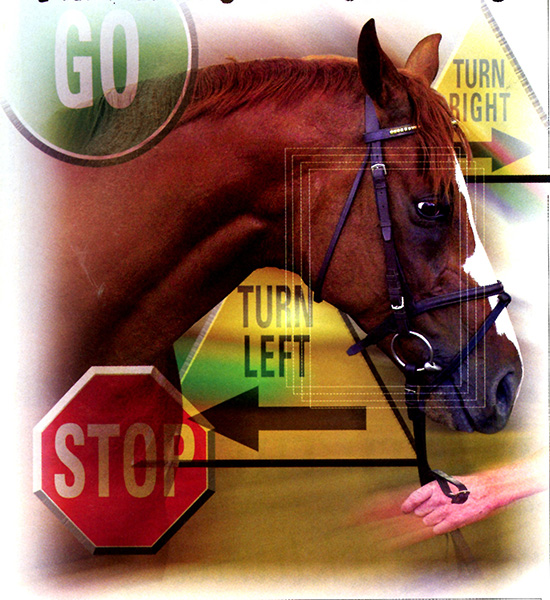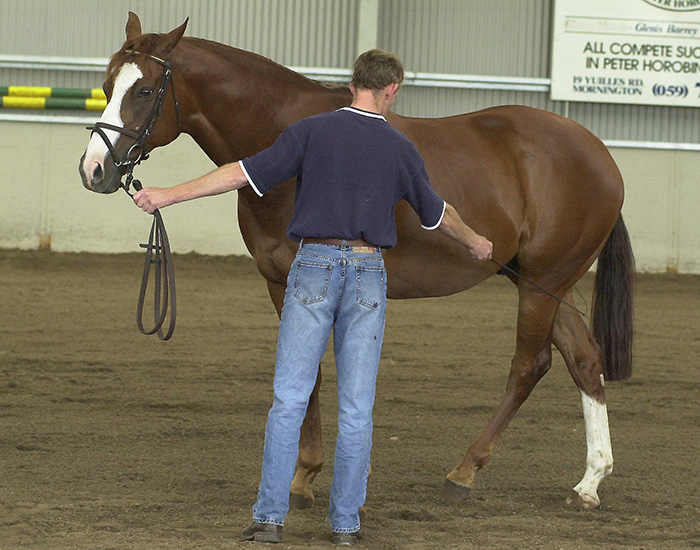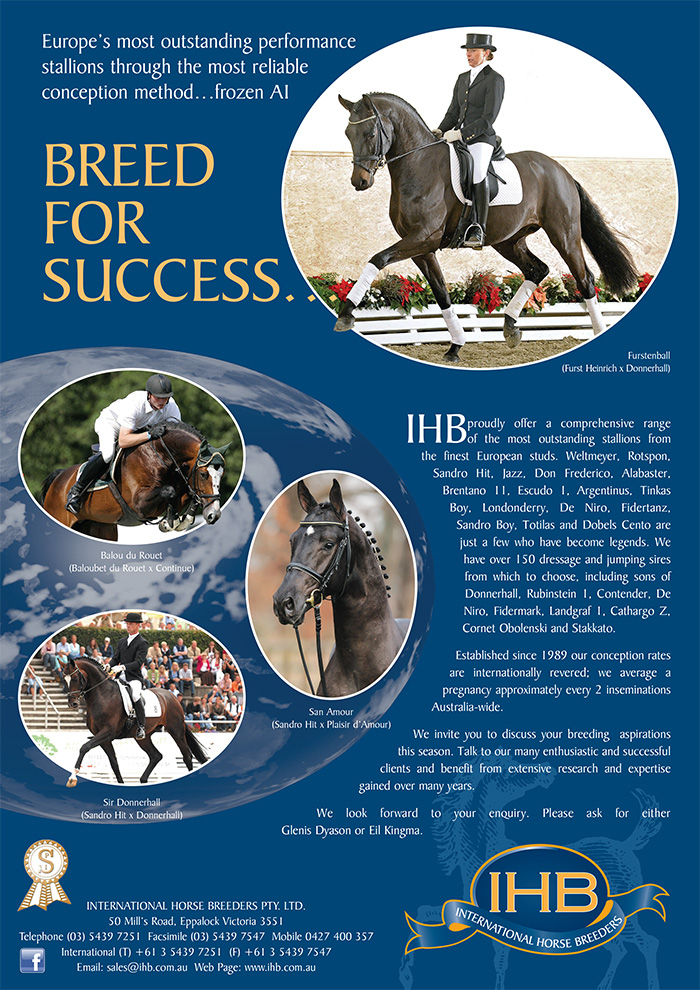 Many riders view the prospect of training their horses in hand as only marginally more interesting than watching paint dry and about as useful. If the horse walks slowly beside them they say he is ‘lazy’, if he invades their space he is ‘dominant’ and if he refuses to load onto the float they might say that he is just plain ‘naughty’. But the truth is, the horse that displays these behaviours is none of these things in so far as his mental awareness is concerned. The horse’s brain is perfectly adapted for its life as a grazing herd member and a large amount of it is dedicated to the technical challenge of propelling 500 or so kilograms at great speeds over varying terrain and little (or none) is wasted on attitude.
Many riders view the prospect of training their horses in hand as only marginally more interesting than watching paint dry and about as useful. If the horse walks slowly beside them they say he is ‘lazy’, if he invades their space he is ‘dominant’ and if he refuses to load onto the float they might say that he is just plain ‘naughty’. But the truth is, the horse that displays these behaviours is none of these things in so far as his mental awareness is concerned. The horse’s brain is perfectly adapted for its life as a grazing herd member and a large amount of it is dedicated to the technical challenge of propelling 500 or so kilograms at great speeds over varying terrain and little (or none) is wasted on attitude.
A ‘naughty’ horse is one that is expressing behaviours that we deem to be inappropriate or incorrect, but from the horse’s viewpoint he is only doing what millions of years of evolution has programmed him to do when things get difficult. The horse is a creature of habit and he is very much trapped by his previous behaviours into giving certain responses to stimuli. He is obedient if he has been trained to be so and ‘naughtiness’ is a barometer, not only of the horse’s temperament but of the quality of the training he has received.
Training the horse to be obedient in hand will not only make him much easier and more pleasant to handle, it will also affect his responses under saddle and make him easier to ride as well.
Horses that are ‘difficult’ or ‘unreliable’ to handle on the ground are displaying what scientists call conflict. Conflict in any one facet of the horse’s training will negatively affect the other facets and will increase the likelihood of training difficulties. Unresolved conflict leads to increased levels of adrenaline and cortisol in the bloodstream which leads to chronic stress.
A prolonged period of stress may cause actual physical changes in the horse such as permanently elevated corticosteroid levels, stress colic and stress ulcers and even predisposition to developing stereotypes such as windsucking and weaving.
Although it seems highly unlikely to us as rational, thinking human beings that a bit of ‘bad’ behaviour on the ground could have all sorts of unpleasant side effects, and even damage our horse’s health, science is hard to refute. Incorrect training leads to conflict and long term conflict leads to poor health.
Quality training produces clear, calm responses that are almost unconditional- that is they occur 99% of the time. The clearer the horse’s responses, the less he is at the mercy of his instincts and behavioural drives. That is, his neural pathways are very clearly established.
Horses that display conflict in hand are far more likely to display conflict under saddle than their better trained stablemates, as the conflict created by the incorrect behaviour under saddle effects the horse both mentally and physically, predisposing it to develop even more conflict.
Training the horse in hand creates a template of obedient responses that will not only make the horse less likely to display conflict while being handled, but will make it easier to train under saddle. One of the most important tools that riders can have in their own repertoire is a basic working knowledge of modern learning theory.
Wherever there are horses and riders there are horses that are destroyed because they are considered to be ‘mad’ or too difficult to ride and I am certain that nearly all of these could have been saved if their trainers understood more fully the work of scientists such as Pavlov and Skinner.
The trainers of other animal species have been utilising modern learning theory in their own training regimes for decades, but it seems that horse trainers, working as they do within a tradition that is centuries old, ignore advances in scientific understanding, preferring to blame their failures on the individual animal, instead of exploring science for rational answers. As horse trainers we work within a culture that expects training wastage, and because our subjects are relatively benign our mistakes are usually not fatal, whereas the trainer of the killer whale or the elephant understands very clearly the need to avoid training related conflict behaviours and utilises all that science has to offer. The guide dog trainer also understands the importance of having clear unconditional learning invested in his charges, thwarting instinctive urges in these dogs such as the tendency to chase cats whenever they see them!
The principles that I will explain in relation to training the horse in hand are also relevant to his training under saddle, in harness or at liberty.
TRAINING YOUR HORSE IN HAND
The aim of your training is to produce a horse that is relaxed, obedient and attentive. When your horse is calm his body posture will reflect this, and his poll will be level with his wither (or lower], his ears loose, his eyes soft and his body supple. This is the posture that your horse should display under saddle during the warmup and also how he should behave, if training is correct, in hand.
People often ask me why I don’t usually include lungeing as a part of the horse’s training in hand. Horses, as all riders know, are flight response animals and their instincts tell them to run away from danger at the slightest provocation. The horse is also a creature of habit and practising a behaviour makes that behaviour much more likely to be repeated . The more a neural pathway is used, the more established it becomes and the harder the behaviour is to eradicate. Lungeing an adrenalised horse allows him to practise flight, when really what we should be doing is not allowing the expression of his flight response at all.
Lungeing can make the horse easier to handle in the short term because it tires him out, but it isn’t actually training him to be calmer and providing a satisfactory long term result.

Leading forward, straight and in self carriage.

Attentive horse and handler holding reins a few inches from the bit. A good example of applying the stop button correctly
lt is important to train the horse so that a single stimulus produces a single response. Each aid that you train should produce only one reaction in the horse; if tapping with a dressage whip on the shoulder causes your horse to rear, strike and leap before coming forward, then the training of this response is very much incomplete. Target the responses that you wish to be repeated by ceasing the stimulus at the instant the horse complies. You can consider training to be established once the horse reliably produces the required responses in a calm manner in a wide variety of situations.
NEGATIVE REINFORCEMENT
Pressure/response/release is the correct term for applying a motivating stimulus or pressure such as the hand, or tapping with a dressage whip and maintaining that stimulus until the horse provides the correct response. lt results in operantly conditioned responses which are the foundation of all further training.
lt is important that there is never more than a one second gap in the pressure and that the pressure is not released in the event of other, incorrect behaviours. Always start by applying the absolute minimum pressure possible and increase the intensity if there is no response. Most importantly, you must release the pressure the instant the horse complies.
Responses trained by negative reinforcement are far more reliable and long lasting than classically conditioned cues such as voice or posture. Many people consider the voice to be an important training aid, but its effectiveness has yet to be conclusively proven. Horses that are trained to stop and go by voice commands alone without a foundation of operant conditioning, pressure/response/release, can be dangerous to ride as those sorts of trained cues usually fail under pressure and, if they are going to be used, need to be trained once the operantly conditioned cues are properly established. That is, if you would like to train your horse to stop to a voice aid, it needs to first stop reliably when you pull on the reins or in an adrenalising situation you will have no way of stopping it at all. 
When you are facing the front, reinforce the go button with the whip.
When you begin training your horse reward every good ‘try’ by softening the pressure of your aid and gradually improve the responses over time. That is, don’t expect the horse to take several steps backwards the first time you apply pressure on his mouth, soften after the first step and expand the response over many repetitions. Consolidate each response and make sure it is reliable before progressing to the next one and never try to blend two responses until each is well established. Do not allow the horse to exhibit behaviours other than those you are training as this can induce conflict.
For example, if you are training him in hand, don’t allow him to take more steps than you have asked for or rub his head on you or graze. The five responses that we train in hand are: Go, stop, head down, yield quarters right and yield quarters left.
Before you begin, the horse should be wearing a rope headcollar or bridle with plain snaffle or rearing bit. Make sure the bridle is fitted correctly and carry a dressage whip if necessary to reinforce the aids. Position yourself so that you are facing the horse’s nearside rump, midway between his head and shoulder, and out of striking range of his front feet. Hold the rein 15-20cm from his chin.

GO
Train the horse to lead obediently from the reins only (not just by copying you when you take a step). To do this, apply forward pressure to reins. If no response, increase pressure. Maintain pressure until horse steps toward you, then immediately release pressure. Remember, it is the moving of his feet only that you reward. Practice at least 3 lots of 5 repetitions per session. If it’s not working – tap with whip continuously (fast, say 2-3 taps/ second) in the area where the brand is on the shoulder while applying rein pressure. Release pressure of both when he steps forward. Don’t stop tapping under any circumstances until you get a forward response.
If he panics from the whip, hold him securely, lay the whip on his body until he is calm and then remove it. This way you are rewarding a calm reaction to the whip.

Remember the whip re–inforces the rein. If it is not working, re-inforce with a whip.
Now you are ready to lead him normally, that is, where you both face the same direction. The reins are now in your right hand, the whip in your left, across your left hip, ready to tap his side if leading is not 100% obedient. Remember, never tap without applying some head pressure, as the whip empowers the lead response.
CAUTION: In the case of foals, pressure the foal to step sideways before forward, as a foal may rear over backwards with strong forward pressure. Use halter without a bit.
STOP:
Train horse to stop by leading him forward, then clearly vibrating the lead toward his chest until his feet are immobile. Remove pressure the very instant immobility occurs. Then deepen the training of stop by training him to take a single step backwards from backwards rein pressure. Again, remove pressure instantly when he steps back, but do not remove pressure until he steps back. Initially, reward every little step back with pressure release. Remember, it is the stopping of his feet only that you reward.
WARNING
– never stand directly in front of bodyline of the horse while training him to go backwards, as there is the possibility that he may strike fast with front legs. This can result in severe injury.
Practise at least 3 lots of 5 repetitions per session.
If it’s not working, vibrate or tug the reins backward. If still no response, tap legs or chest with whip continuously until he goes back just a single step, then instantly cease whip-tap and rein pressure. But don’t stop until he does go back.

The horse should stop wherever you choose.
Eventually consolidate his stopping response further by stopping everywhere, in puddles etc. Disallow stopping reactions of his own making. Check that he is not just copying you, but actually stopping correctly by continuing to move while applying the stop response.
HEAD DOWN:


lt’s important to achieve the head all the way down to the ground. This really calms the horse. In the bottom pic you can see how the horse looks sleepy and relaxed.
Train the horse to lower his head from downwards pressure of reins. To do this, apply pressure downwards, then lighten the instant he lowers, even just a little. But don’t any remove pressure until he lowers a little. Gradually train him to lower further by adding more downward pressure after he initially lowers. By being accurate in the timing of your release, your horse will soon lower his head from a light touch.
Practice at least 3 lots of 5 repetitions per session.
Caution: Do not position yourself so that the horse’s head is anywhere near underneath yours, as a sudden jerk upwards of the horse’s head can cause severe injury to yours!

YIELDING HINDQUARTERS:
Hold the whip in your right hand, horse in your left, and tap him continuously on hock joint until he steps a little away from the whip toward his opposite leg. Shape his response by ceasing to tap him only when he crosses his opposing hock. Practice at least 3 lots of 5 repetitions per session.
Consolidate by yielding him wherever you choose. Perfect these manoeuvres, so they end up happening from light aids, and you can put the whip away.
No voice commands until well after consolidation – remember, release of pressure is the effective reward . Remember good work in hand will make foundation work (Breaking) much easier.
This article originally appeared in the June 2001 edition of THM




